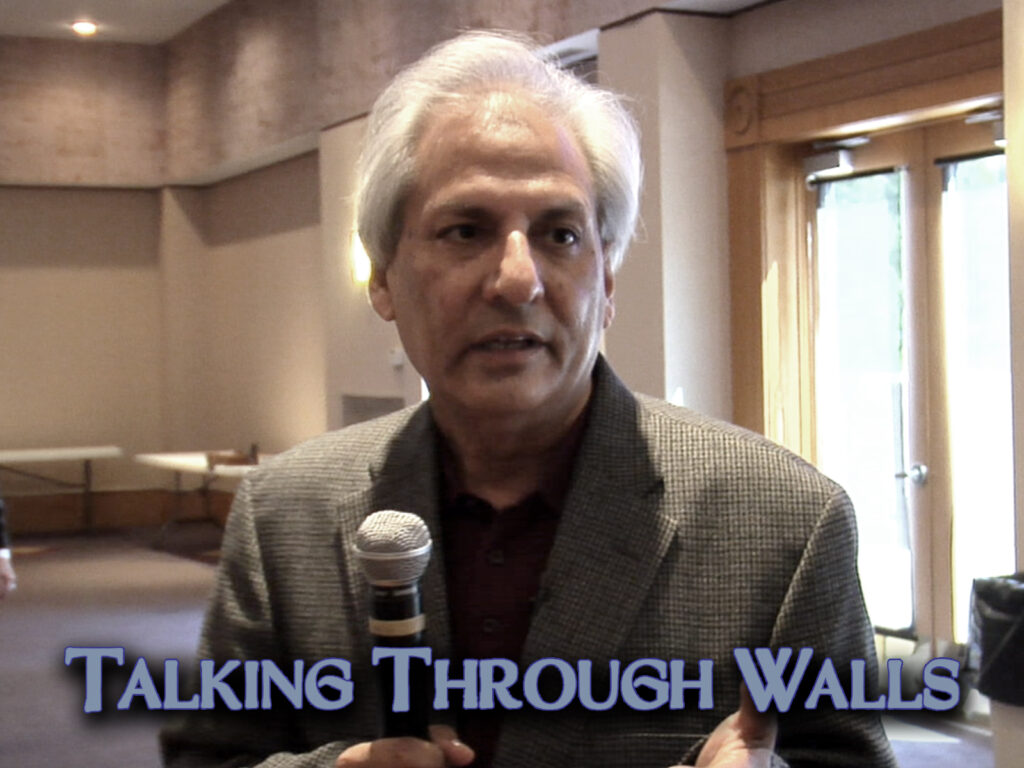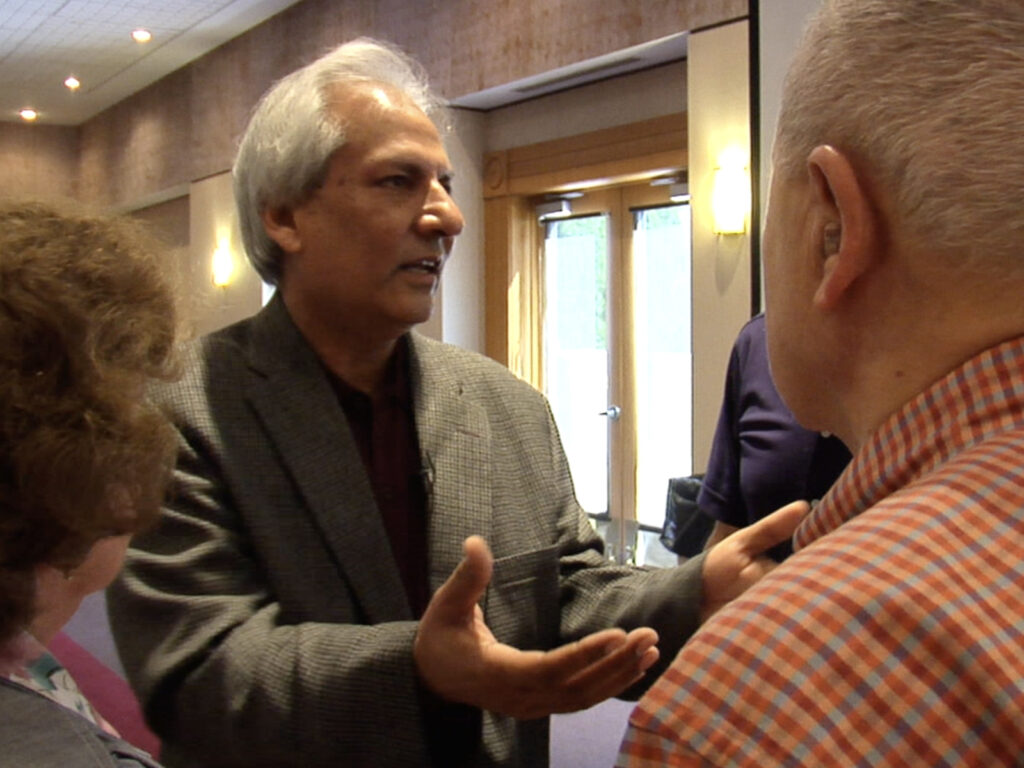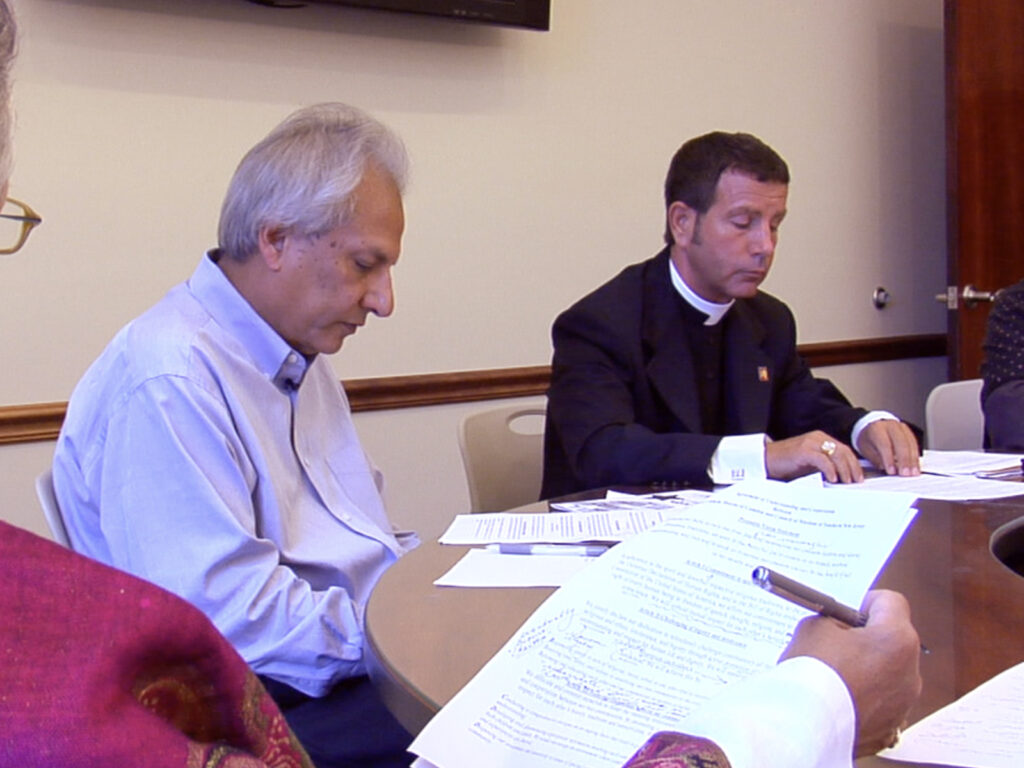
Talking Through Walls
How the Struggle to Build a Mosque Unites a Community
Talking Through Walls: How the Struggle to Build a Mosque Unites a Community takes viewers into the life and struggle of Zia Rahman, a determined but ailing man, who sets out to build a mosque in his suburban community. The hour long film was broadcast on select PBS stations in 2007 and 2008.
The Quest to Build a Mosque in Voorhees, New Jersey
In the fall of 2003, America marked the second anniversary of September 11th as the White House was busy defending the Iraqi invasion. At a press conference, White House Press Secretary Scott McClellan said:
The attacks of September 11th taught us that we must confront the new, dangerous threats of the 21st century…. The nexus between outlaw regimes with weapons of mass destruction and terrorist organizations is the most dangerous threat of our times.
White House Press Secretary Scott McClellan
That fall, Zia Rahman prepared to appear before the zoning board in his hometown of Voorhees, New Jersey. Rahman was ecstatic that he finally had amassed enough funds to purchase a vacant building near his own upscale home. In his dream, this dilapidated structure would become a long awaited mosque for his Muslim neighbors. Rahman explains, “If you had seen what was there before the mosque… I thought we were going to beautify it and make a place where God’s word is going to be spoken.”
Talking Through Walls, a Unity Productions Foundation-produced documentary, tells the inspiring story of Zia and the interfaith coalition that overcame the resistance of fearful Voorhees residents to build the mosque. It is a story that pits tolerance against intolerance in an uncertain world.
Talking Through Walls is currently being broadcast on PBS stations nationwide. Check local listings.
Anonymous Flier Stokes Fear of "Muslim radicals"
A mostly white, middle- to upper-middleclass bedroom community of Philadelphia, with a population of about 29,000, Voorhees has a high percentage of white collar workers and a median family income of $87,000. Like many communities, Voorhees has grown quickly in recent years. Farmland has been transformed into new housing developments. The main artery, State Road 73, is congested at rush hour. Wedged between luxury retail malls and a new Whole Foods are small auto mechanic shops and diners.
Rahman didn't expect the extent of his neighbors' resistance to the proposed mosque. Rumors began to spread, and an anonymous flier was disseminated throughout the small town.
Muslim worshippers who are extremists and radicals can pray side by side with conservative believers. These extremists and radicals could include individuals with connections to terrorists.
- Excerpt from the flier
An Individual Speaks Up for Fairness and Respect
Voorhees resident Lori Volpe was shown the flier by her neighbor and came to the zoning board hearing where Zia Rahman sought approval to change the site use from commercial to religious. An environmental activist and yoga teacher, Volpe described the hearing, saying that residents vocally objected to the mosque and feared the connections the Muslims might have with terrorism. "They were afraid that people would be violent, and that their own children would get caught in the crossfire."
Volpe listened as, one by one; residents expressed their displeasure with the proposed building of the mosque. Some compared it to Mecca and were worried that thousands of Muslims would flock to Voorhees. The zoning board was unequipped to handle residents' questions and in turn asked Rahman questions Volpe termed "completely outrageous and inappropriate." They wanted to know how Muslims pray and asked how much space it takes when practitioners bow down. At 2 AM, Volpe stood to speak. Her neighbors thought she would object to the mosque for environmental reasons, as she usually spoke out against development. Volpe looked at her white, middle class neighbors on one side and the darker-skinned Muslims on the other side of the aisle, the women's heads covered. She thought carefully about what she wanted to say. She spoke convincingly about America and the rights citizens have to practice the religion of their choice. The zoning board granted Rahman the use variance.
Support for Religious Freedom from the Coalition for a Multi-faith Democracy
Still, there was hostility in the community. The realtor who represented the seller received calls warning him not to sell the property to Rahman. So Volpe reached out to her friend, Joan Spangoletti, a member of the Religious Society of Friends and contacted her Unitarian Minister, Rev. Melanie Sullivan. Sullivan contacted Rohn Hein, another Unitarian, and Rev. Charles Sayers, a Methodist minister. This group formed the Coalition for a Multi-faith Democracy, which later expanded to include a representative from St. Andrew's Catholic Church and a Jewish neighbor, Jerry Tennenbaum. They began a letter-writing campaign to local newspapers in support of religious freedom and contacted the Anti-Defamation League (ADL) of New Jersey. Both the ADL and the Interfaith Freedom Foundation in California supported the Coalition and created more noise in the press. Suddenly, the Voorhees mosque had friends in high places.
The ADL's involvement led to Alan Respler of the Jewish Community Relations Council (JCRC) contacting Rahman and lending his support. Says Respler, "Since this case dealt with bigotry, it was something that I had interest in… Most Americans don't know anything about Islam. And it was especially bad after 9-11."
Greater Understanding of Islam Could Have Prevented the Zoning Conflict
Kathleen Foley, who was doing doctoral research on building mosques in the US, says that the conflict could have been reduced had the zoning board been more educated about mosques. She says that the volunteer zoning board's need to find out how mosques function distracted them from the zoning issues. "The issue could have been easily resolved if conversation had been calm; instead there was struggle."
Foley described how a community member held up a prayer rug, asking how a person could fit on the rug, implying that Rahman was lying about the amount of space he needed. According to Foley, this unawareness is repeated all over the US, as the growth of Islam in America increases requests to zoning and planning boards.
Ultimately, Rahman's mosque did get built. The dilapidated building was razed, and, in its place, a new building now stands, one that looks like it belongs in the neighborhood. Children attend after school Quran reading sessions taught by Rahman's wife, Zahida. Rahman says that about five men pray there daily. On Friday afternoons, up to 15 men come to pray for the Salat al- Jumu'ah, the congregational prayer.
Experience with Vorhees Mosque Leads to Educational Outreach
Rahman could have praised Allah and shut the door. Instead, he opened the mosque and invited the whole community in to gain a better understanding of Islam. The alliance that he made with Respler and the JCRC has blossomed into a major educational outreach initiative.
When Quresh Dahodwala wanted to build a Bohra mosque in Cherry Hill, New Jersey, he consulted Rahman and Respler. Dahodwala's mosque awaits final approval from the New Jersey DEP and is scheduled to break ground in May. While there were compromises made - the Bohra mosque will have a minaret, albeit slightly shorter than originally designed - the process was not fraught with the emotions that complicated Rahman's quest to build the Vorhees mosque.
Now the group reaches into the community to bridge the divides between Muslim, Jew, Christian and Hindu. With interfaith prayer meetings, dinners that feature halal and kosher meals, and workshops with high school students, the group is committed to open dialogue. As Alan Respler says, "Once you start seeing people as individuals, that's how you break down and overcome preconceptions and stereotypes."
Rahman is philosophical about the struggle to build the mosque in Voorhees. He doesn't blame his neighbors for their misconceptions of Islam. In fact, he seeks to learn from the experience. "It was the opportunity that God gave me to take the message out of my home into the community." And that's exactly what he does, daily.
Watch the Film Trailer
What Others Say About the Film
The extensive credits of Executive Producers Alex Kronemer and Michael Wolfe span over 10 years of film making and include: Enemy of the Reich; Islamic Art: Mirror of the Invisible World; Inside Islam: What a Billion Muslims Really Think; Allah Made Me Funny; On a Wing and A Prayer: An American Muslim Learns to Fly; Talking Through Walls; Prince Among Slaves; Cities of Light: The Rise and Fall of Islamic Spain; and Muhammad: Legacy of a Prophet.
This film was produced and directed by Rob Gardner, whose credits include Arab and Jew: Wounded Spirits in a Promised Land; Islam: Empire of Faith; Inside Islam: What a Billion Muslims Really Think; Cities of Light: The Rise and Fall of Islamic Spain; and Rome: Rise and Fall of an Empire.



Review the Film
We love feedback. We can't promise to include all submitted reviews on our site, but if you submit your review you're letting us include it in whole or in part. Required fields are marked with a red asterisk *.
"*" indicates required fields







